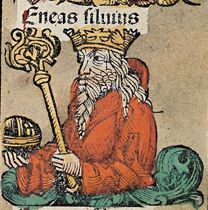 W
WAeneas Silvius is the son of Silvius, in some versions grandson of Ascanius and great-grandson, grandson or son of Aeneas. He is the third in the list of the mythical kings of Alba Longa in Latium, and the Silvii regarded him as the founder of their house. Dionysius of Halicarnassus ascribes to him a reign of 31 years. Ovid does not mention him among the Alban kings. According to Livy and Dionysius the heir of Aeneas Silvius was named Latinus Silvius.
 W
WMarcus Ambivulus was Roman Prefect of the province of Judea, comprising biblical Judea and Samaria. Originally a cavalry officer, he succeeded Coponius in AD 9 and ruled the area until AD 13, when he was succeeded by Annius Rufus. Josephus noted his tenure in the Antiquities of the Jews 18.31.
 W
WFlavius Anastasius Paulus Probus Moschianus Probus Magnus was a Byzantine statesman who served as Consul in 518.
 W
WMarcus Antonius Primus was a senator and general of the Roman Empire.
 W
WGaius Appuleius Diocles was a Roman charioteer who became one of the most celebrated athletes in ancient history. He is often cited as the highest-paid athlete of all time.
 W
WArbuscula was a woman stage performer of ancient Rome. She was a celebrated actor in pantomimes during the 1st century BCE, when most of the female parts at the time were played by men at least in tragedy.
 W
WIn the legendary history of ancient Rome, Attus Navius was a famous augur during the reign of Tarquinius Priscus.
 W
WAudax, Ditalcus and Minurus were Turdetanian warriors who participated in the Lusitanian War. They were the supposed betrayers and assassins of the Lusitanian leader Viriathus.
 W
WIunius Bassus signo Theotecnius was an ancient Roman politician. The son of the praetorian prefect Junius Annius Bassus, he was vir clarissimus and vicarius of Rome as well as praefectus urbi from 25 March to 25 August 359.
 W
WBathyllus was a dancer/performer of pantomimus in Rome during the period of Augustus. Born in Alexandria, he was the favourite of Maecenas.
 W
WBonosus was a late 3rd-century Roman usurper. He was born in Hispania to a British father and Gallic mother. His father—a rhetorician and "teacher of letters"—died when Bonosus was still young but the boy's mother gave him a decent education. He had a distinguished military career with an excellent service record. He rose successively through the ranks and tribuneships but, while he was stationed in charge of the Rhenish fleet c. 280, the Germans managed to set it on fire. Fearful of the consequences, he proclaimed himself Roman emperor at Colonia Agrippina (Cologne) jointly with Proculus. After a protracted struggle, he was defeated by Marcus Aurelius Probus and hanged himself rather than face capture.
 W
WBrinno was leader of the Canninefates when they joined in the Batavian rebellion at the mouth of the Rhine in AD69. According to Tacitus he was:...a man of a certain stolid bravery and of distinguished birth. His father, after venturing on many acts of hostility, had scorned with impunity the ridiculous expedition of Caligula. His very name, the name of a family of rebels, made him popular. Raised aloft on a shield after the national fashion, and balanced on the shoulders of the bearers, he was chosen general".
 W
WPublius Canidius Crassus was a Roman general and Mark Antony's lieutenant. He served under Lepidus in southern Gallia in 43 BC, and was henceforth allied with Antony. He became suffect consul in 40 BC and then served as a commander in Armenia whence he invaded, in 36 BC, Iberia (Georgia), and forced its king Pharnabazus into alliance against Zober, king of Albania. Having subjugated the Iberians and Albanians, Crassus then joined Antony's campaign against Parthia.
 W
WLucius Cocceius Auctus was a Roman architect employed by Octavian's strategist Agrippa to excavate the subterranean passageways known as the crypta neapolitana connecting modern-day Naples and Pozzuoli and the Grotta di Cocceio, connecting Lake Avernus and Cumae. Cocceius was responsible for the conversion of the Capitolium in Pozzuoli into a Temple of Augustus with the backing of the merchant Lucius Calpurnius. Cocceius Auctus also built the original Pantheon in Rome.
 W
WLucius Vitruvius Cerdo was an ancient Roman architect active in Verona. His only known work is the Arco dei Gavi, a 1st-century arch in Verona, Italy. The arch is inscribed "Lucius Vitruvius Cerdo, a freedman of Lucius", which has led to Verona being suggested as the birthplace of the earlier and better-known architect Marcus Vitruvius Pollio.
 W
WPublius Cornelius Scipio Nasica was a consul of ancient Rome in 191 BC. He was a son of Gnaeus Cornelius Scipio Calvus. Sometimes referred to as Scipio Nasica the First to distinguish him from his son and grandson, he was a cousin of Scipio Africanus.
 W
WTiberius Claudius Donatus was a Roman Latin grammarian of the late 4th and early 5th century AD of whom a single work is known, the Interpretationes Vergilianae, a commentary on Virgil's Aeneid. His work, rediscovered in 1438, proved popular in the early modern age; 55 editions of this book were printed between 1488 and 1599.
 W
WThe chieftain called by Latins Donnus was the ruler of the Ligurian tribes inhabiting the mountainous region now known as the Cottian Alps during the 1st century BC. Although initially an opponent of Julius Caesar during the latter's conquest of Gaul, Donnus later made peace with him. Donnus' son and successor, Cottius, initially maintained his independence in the face of Augustus' effort to subdue the various Alpine tribes, but afterwards agreed to an alliance, and the family continued to rule the region as prefects of Rome, until Nero annexed the dominion as the province of Alpes Cottiae. His name was first cited in the Arch of Augustus of Susa engraving.
 W
WFestus, whose name also appears in the manuscripts of his work as Rufus Festus, Ruffus Festus, Sextus Festus, Sextus Rufus, and Sextus, was a Late Roman historian and proconsul of Asia whose epitome Breviarium rerum gestarum populi Romani was commissioned by the emperor Valens in preparation for his war against Persia. It was completed about AD 370. The Breviarium covers the entire history of the Roman state from the foundation of the City until AD 364. The book consists of 30 chapters treating events in Roman history in terse overview, mainly focused on military and political conflicts. It is estimated as a work of very low quality.
 W
WQuintus Fufius Calenus was a Roman general, and consul in 47 BC.
 W
WIaia of Cyzicus, sometimes (incorrectly) called Lala or Lalla, was a Roman painter, alive during the time of Marcus Terentius Varro.
 W
WJesus son of Damneus was a Herodian-era High Priest of Israel in Jerusalem, Iudaea Province.
 W
WGaius Julius Alpinus Classicianus was procurator of Roman Britain from 61 to his death in 65.
 W
WJulius Marinus was the father of Roman Emperor Philip the Arab and Philip's brother Gaius Julius Priscus. He was deified by his son. Scholar Pat Southern writes that this deification was unusual because Marinus was not an emperor, but it gave Philip's reign more legitimacy.
 W
WJulius Sacrovir was a member of the gens Julia. Alongside Julius Florus, leader of the Treveri, he led the Aedui tribe in Gaul in a revolt against the Romans.
 W
WSextus Julius Saturninus was a Roman usurper against Emperor Probus.
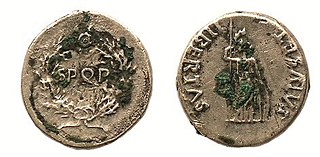 W
WGaius Julius Vindex, of a noble Gallic family of Aquitania given senatorial status under Claudius, was a Roman governor in the province of Gallia Lugdunensis. He was one of the men belonging to the faction of the powerful mother of Nero, Empress Agrippina and took part in a conspiracy against the emperor in 59. However, with the assassination of Agrippina by Nero, this faction was dissolved.
 W
WIunius Annius Bassus was a praetorian prefect of the Roman Empire from 318 to 331, during which time he also held the consulate. Several laws in the Codex Theodosianus are addressed to him. His son Junius Bassus was praefectus urbi, and his sarcophagus from 359 CE is one of the most decorative late antique sarcophagi adorned with two registers of Christian scenes.
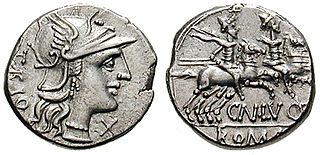 W
WGnaeus Lucretius Trio was a Roman moneyer, who minted denarii in Rome c. 136 BCE. He may be an ancestor of Lucius Lucretius Trio.
 W
WLucius Lucretius Trio was a Roman moneyer, who minted two denarii in c. 76 BCE.
 W
WGaius Licinius Macer was an official and annalist of ancient Rome.
 W
WMaeonius, or Maconius, was a short-lived Roman usurper.
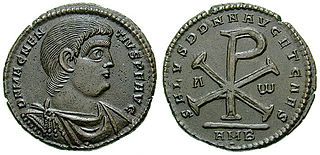 W
WMarcellinus was a Roman Empire officer under Roman Emperor Constans and usurper Magnentius.
 W
WEgnatia Mariniana was probably the wife of Roman Emperor Valerian and mother of Emperor Gallienus.
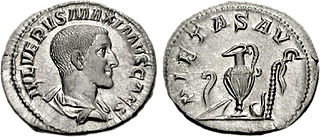 W
WGaius Iulius Verus Maximus, Massimo and Massimine in Italian, also incorrectly called Gaius Iulius Verus Maximinus or Maximinus the Younger was the son of the Roman Emperor Maximinus Thrax and his wife, Caecilia Paulina.
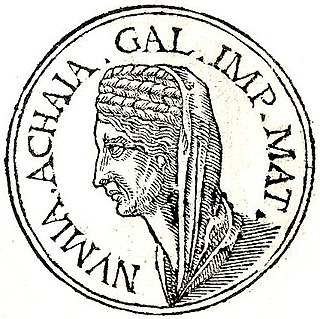 W
WMummia Achaica was the mother of the Roman Emperor Galba and his elder brother Gaius. She was the granddaughter of Quintus Lutatius Catulus and great-granddaughter of the general Lucius Mummius Achaicus. She died shortly after Galba's birth.
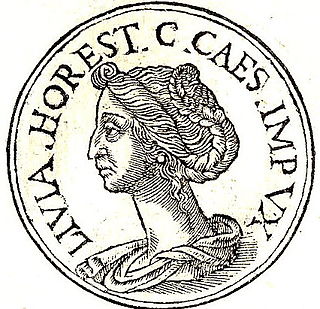 W
WLivia Orestilla was the second wife of the Roman Emperor Caligula in AD 37 or 38.
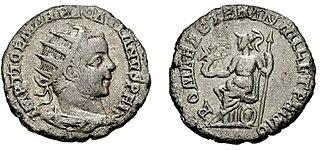 W
WTiberius Claudius Marinus Pacatianus was a usurper in the Danube area of the Roman Empire during the time of Philip the Arab.
 W
WThe Malibu Painter was an Ancient Roman painter of Fayum mummy portraits active in Egypt between about 75 and 100 AD. Three portraits have been attributed to him, based on his manner of painting highlights and shadow and the distinctive form of the noses and mouths in his portraits. Two paintings were found at Hawara, and it appears that the painter was primarily active in nearby Arsinoe. The artist's name is derived from a portrait of a woman now found in the J. Paul Getty Museum in Malibu, Los Angeles.
 W
WSextus Placitus of Papyra,, an ancient Roman physician, is best known for his Libri medicinae Sexti Placiti Papyriensis ex animalibus pecoribus et bestiis vel avibus Concordantiae.
 W
WIn the Historia Augusta, Postumus the Younger figures as one of the so-called Thirty Tyrants who usurped power against the Roman Emperor Gallienus. According to the pseudo-historical list of 'Thirty Tyrants', the Emperor of the Gallic Empire Postumus had a son, also called Postumus, whom he nominated to be first caesar, and later even augustus and co-ruler. Postumus the Younger would have been killed together with his father in 268, during the rebellion of Laelianus.
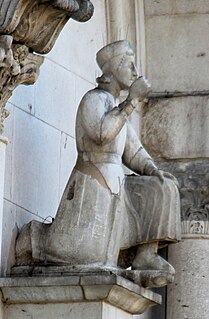 W
WLucius Orbilius Pupillus was a Latin grammarian of the 1st century BC, who taught at school, first at Benevento and then at Rome, where the poet Horace was one of his pupils. Horace criticizes his old schoolmaster and describes him as plagosus, and Orbilius has become proverbial as a disciplinarian pedagogue.
 W
WLucius Salvius Otho was the father of the Roman emperor Otho. He was born of a distinguished and well-connected family on his mother's side. His close friendship with Tiberius, and physical similarity to him, led to rumours that he was Tiberius's son.
 W
WSaturninus is mentioned in the Historia Augusta as a Roman usurper during the reign of emperor Gallienus (253-268). He is very probably a fictional construction by the author of the Historia Augusta.
 W
WFlavius Scorpus also known as Scorpius was a famous charioteer in Roman times who lived at the end of the 1st century AD. Scorpus rode for the Green faction during his lifetime and accumulated 2,048 victories. As one of the most famous drivers in Roman history, Scorpus earned extraordinarily large amounts of money; his income surpassing that of professional Roman sponsors. Scorpus died young, at 27 years of age.
 W
WSebastianus, a brother of Jovinus, was an aristocrat of southern Gaul. After Jovinus usurped the throne of the western Roman Emperor Honorius in Gaul in 411, he named Sebastianus as Augustus (co-emperor) in 412. Coins bearing Sebastianus' image were then minted at Arles and Trier.
 W
WMarcus Sergius was a Roman general during the Second Punic War. He is famed in prosthetics circles as the first documented user of a prosthetic hand. The metal hand was constructed to allow him to hold his shield in battle.
 W
WSponsianus is believed to have been a Roman usurper, who attempted to seize the throne during the 240s, likely during the rule of Philip the Arab. The sole evidence for his existence is a single aureus of dubious quality.
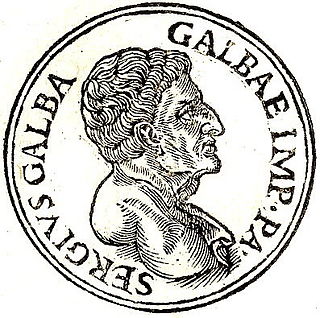 W
WServius Sulpicius Galba was a Roman general and politician, praetor in 54 BC, and an assassin of Julius Caesar.
 W
WFlavia Maximiana Theodora, also known as Theodora, was a Roman Empress, wife of Constantius Chlorus.
 W
WValens Thessalonicus was a Roman usurper during the reign of Emperor Gallienus.
 W
WA Triumvir Monetalis was one of three moneyers appointed in Ancient Rome to oversee the minting of coins.
 W
WTuccia, was an ancient Roman Vestal Virgin.
 W
WUranius is the name of two possible Roman usurpers of the third century.
 W
WMagnia Urbica was wife of the emperor Carus, until recently mistaken to be the wife of his own son Carinus. While both Carinus and Numerian were killed in 284, it is unclear what her own fate may have been or even if she predeceased them. She was granted the honorifics Augusta, and Mater castrorum, senatus ac patriae, "Mother of the (Military) camp, Senate and Fatherland".
 W
WVictoria, also known as Vitruvia, was a leader in the Roman breakaway realm known as the Gallic Empire in the late 3rd century. She was the mother of Victorinus, who ruled as Gallic Emperor until his assassination in 271. Afterwards, Victoria used her authority to stabilize the empire and select a successor.